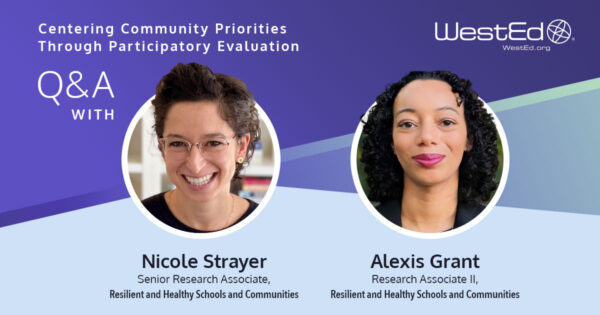
December 29, 2015
When officials at North Elementary School in Okeechobee, Florida, cancelled the school’s Carnival and Family Reading Night, parents were a bit confused and somewhat dismayed. Such events had been long-standing ways of encouraging them to get involved in their children’s school. But North Elementary’s principal, Pat McCoy, realized that “while events like a school carnival offer a nice chance to socialize, they don’t actively engage parents in their child’s learning.”
So McCoy decided to take a different approach. To help families play a more informed and active role in their children’s education, North Elementary adopted WestEd’s Academic Parent–Teacher Teams (APTT) system. Developed in 2009 in the Creighton Elementary School District (Arizona) by Maria Paredes, now a WestEd senior program associate, APTT gives families concrete information on their children’s academic progress and provides them with skills, strategies, and resources to use at home with their children to reinforce targeted grade-level learning goals.
“To be truly engaged in their child’s education,” says McCoy, “parents have to know what’s happening in the classroom and know exactly what they can do at home to support learning.”
Building on over four decades of research indicating that family engagement is one of the strongest predictors of students’ academic success, APTT takes a more focused and academically oriented approach than most traditional school family-participation events. Over the course of the school year, the APTT model features three 75-minute team meetings that include the teacher and the parents of all the students in the class, along with one 30-minute individual session between the teacher and each student and their parents.
At sites around the country, APTT has helped increase family engagement and improve student achievement. When working in Creighton during the 2011/12 school year, for example, Paredes used standardized test scores from grades 1 through 8 to compare the gains in reading and math of those students whose parents participated in APTT with those whose parents did not. She found that although 40 percent of APTT students entered school performing “well below average” in reading, that figure had dropped to 10 percent by spring. For non-APTT students, the amount of change in reading performance was lower: from 28 percent to 9 percent. In math, 71 percent of APTT students were performing “well below average” in the fall, compared with only 18 percent by spring. Their non-APTT peers went from 58 percent performing at “well below average” in math in the fall to 22 percent by spring.
Moving Beyond Parent–Teacher Conferences
“Once parents saw the genuine partnerships we were building through APTT and how that was helping their children,” says McCoy, “they realized this approach is far more productive than the more socially oriented events we used to hold.”
At the first team meeting, parents learn about one of the teacher’s specific expectations for his or her students. In first grade, for example, this expectation might be that students can identify a certain number of sight words by the end of the semester. Parents are also shown academic performance data that indicate how close each child in the class is to meeting that expectation. (Teachers protect student privacy by identifying each child with a random number known only by his or her parents.)
Over four decades of research indicate that family engagement is one of the strongest predictors of students’ academic success.
McCoy says this information helps parents commit to the partnership. “They say, ‘Oh, my child is not doing as well as he should, so I’d better learn how to help my child improve his skills.’”
Teachers then help parents set 60-day goals for their children, specifying, for instance, how many new sight words they want their child to learn and how much time per week they will dedicate to practicing specific activities with their children at home to meet those goals. “The parents practice the activities with the teacher and with each other,” says McCoy, “and we send them home with a goal sheet and any necessary learning aids for their children, like word games and flash cards.” The second and third team meetings, which take place in January and April, involve teachers sharing follow-up test data, introducing new target skills, and working with parents to set new goals for each student.
Promoting Equity
Children thrive in school when their home environment and community afford them the opportunity to explore unique ideas, meet new challenges, and tap into their social and cognitive potential with the support of caring adults, says Paredes. “But there are many children who struggle to catch up because they haven’t been exposed to the same level of learning opportunities and high parental expectations,” she adds. For too long, schools in disadvantaged communities have tried to erase those sort of disparities in children’s home learning environments by “taking full responsibility and accountability for student learning and achievement,” says Paredes.
APTT is allowing parents to share in that responsibility by ensuring they gain confidence with a whole new set of skills, strategies, and tools they can use with their children, says Paredes. “The APTT approach gives parents a deeper understanding of their roles and responsibilities. Sharing in that knowledge and building parents’ confidence and ability to support their children’s learning is what equity is all about.”
McCoy notes that at North, where about 46 percent of students are non-native English speakers and 76 percent qualify for free- or reduced-priced lunch, staff initially had to work hard to ensure parents attended APTT meetings. But by spring, attendance at six parent-engagement events at the school, four of which were APTT-related, totaled 1,428 — a figure more than five times the attendance recorded at any of the district’s four other elementary schools. It was also a significant jump from parent attendance in previous years at North.
Meetings are held first thing in the morning to best accommodate parents’ schedules, notes McCoy. “Parents say it’s easier to tell to a boss, ‘I’m going to be a few minutes late because of a meeting at my child’s school’ than to ask to leave work early.”
Boosting Student Achievement
Paredes is proud of the positive impact APTT is having at schools and districts across the country. For instance, a study of APTT in the Houston Independent School District during 2014/15 found that students whose parents attended APTT meetings had a higher, “statistically significant” rate of growth in word fluency skills than their peers whose parents did not participate. According to researchers, the gains were linked to the skills families learned in the first and second APTT meetings. Indeed, parents reported feeling more empowered, with one noting, “I think my child did better [after APTT] because I never knew how to help with her education before.”
In another recent study, Johns Hopkins University evaluated two family engagement practices — APTT and home visits — used in 24 Washington, DC, schools from 2012 through 2014. The researchers found “near unanimous” support for APTT from parents and teachers. More than 94 percent of parents queried said APTT meetings improved the way they helped their children with schoolwork, and approximately 90 percent of teachers reported that APTT meetings enhanced family engagement and parent-teacher relationships.
Although McCoy doesn’t yet have the data comparing students’ academic performance, she believes that those children whose parents participated in APTT at North last year made “significantly more progress” than those whose parents did not.
Paredes is also encouraged by how the APTT model continues to expand and impact more families and students. In the last couple of years alone, it has grown from being in place in schools in five states to reaching approximately 200,000 families in 18 states.
Critical to its success, Paredes says, is the high-quality professional development and technical assistance offered by WestEd consultants, who typically work with a school or district for two years. Consultants demonstrate to teachers how to discuss student goals in parent-friendly language, share student performance data, and model engaging activities for home practice. To ensure schools are well supported, consultants follow up on trainings with site visits to observe APTT meetings, debrief principals, and recommend strategies to improve outcomes for teachers and families.
Moving forward, Paredes hopes more schools will focus on strengthening and professionalizing family–school partnerships as a way to extend student learning time to 365 days a year. “The more we can empower families to engage with schools and support their children’s learning,” says Paredes, “the better off all students will be.”









